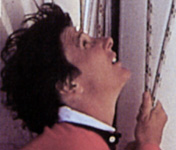 Isabelle Autissier
Isabelle AutissierA high pressure system has expanded further east from the African continent and created lots of wind south of 45 S and east of 40 E. This conditions favored the leaders who reached furthest south and east while light winds prevailed for all competitors sailing in the more easterly and northerly positions.
 Isabelle Autissier
Isabelle Autissier
It reflected in Autissier's performance. She was southernmost from the whole fleet and almost furthermost east. She was making better than 17 knots, about two knots faster than the rest. Despite her early problem with her keel she established over 30 mile lead over Soldini in second position. As she described in her email she was ready for the next front to come: "I spent a sleepless night waiting for the front's wind shift, but better that than to have the boat in a mess if the shift is fast and you haven't seen it coming. The night was black as ink and very cold; wind 30-35 knots, but seas manageable. I'm still talking with Pascal Conq about a more permanent repair to the hydraulic ram. The barometer is rising strongly. We have to stay south, to avoid a high that will be far to the south. Pretty hard to get any rest in this washing machine screaming along at 20 knots. We're close to the islands, and there are lots of birds. Yesterday, I passed within 15 miles of Prince Edward Island."
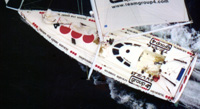 Golding's Team Group 4
Golding's Team Group 4
Mike Golding on third position was less cautious about the weather and he almost dearly
paid for his relaxed attitude as he described in his message: "Last night I rudely
woke from a nap when I was slung head first from the central navigational seat. Team Group
4 had crash gybed and was rapidly laying over at 90 degrees. I had been blast reaching at
up to 22kts with all three sails set in around 25kts of wind. A front had come through
rapidly shifting the wind through 40 degrees. On deck the problem is a bit like 'pick up
sticks'. Do anything in the wrong order and the racing at least, is over. The biggest
issue is the rig, then the sails, and finally not allowing the boat to start sailing
backwards, possibly damaging the rudders during the righting process. With the mainsail
pressed up against the runners and all the sails aback, the boat will not come up - even
moving the keel the full 90 degrees -- and it would further load up the rig. At least with
the boat laid over there is very little wind pressure in the sails. Having decided to stay
on the new gybe, I began unloading the water ballast and getting the keel back to centre.
Bringing the new runner on and furling the genoa, are tricky jobs at 90 degrees, but once
done the boat showed some signs of wanting to come up. Easing the old runner and keeling
fully finished the job. An extra reef in the main saw us of at 20 knots again and all that
was left was the clearing up below, hand pumping the remaining water ballast on port, and
loading the new ballast on starboard. All told, Team Group 4 was probably on her side for
30 minutes with an hour's clearing up and getting back up to speed. Amazingly there
appears to be no damage!"
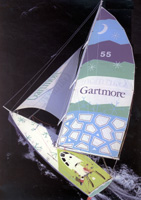 Hall's Garmore Invest. Mgmt.
Hall's Garmore Invest. Mgmt.
Josh Hall in fifth place experienced the same trouble: "Well last night I had a rather humbling Southern Ocean experience. We were running hard at 16-20 knots when the boat crash gybed suddenly on a big wave, the mainsail slammed over and we were pinned on our beam end with the ballast in the wrong side. I was tossed off the chart table seat onto a bunk and then scrambled out into a near vertical cockpit. To right the boat I had to release everything and the roller headsail flogged wildly as I had to leave it to its own devices - my priorities were to sort out the running backstays to keep the rig in the boat and get the boat on her feet again. It took about an hour to re-gybe, by which time an expected cold front had swept in with 35+ knots of SWly. The headsail didn't furl properly as it was flogging out of control, leaving a pocket of sail exposed to the wind. The sheets that control it had wrapped themselves in a bar tight snake's honeymoon around the roller drum so the next two hours were spent on the bow straightening it all out before I could fully furl it. With the water temperature down at 4 degrees Celsia the icy waves that doused me every couple of minutes were less than helpful and I must admit a couple of times I just sat there looking back at the boat floodlit by the deck lights and the wake trailing astern as she surged along in the big waves and thought, at the same time - 'Wow - this is awesome!' and 'What on earth am I doing here?!' With the headsail back under control it was clear that I needed to put a third reef in the mainsail, and then set the staysail. Amazingly, a drama that took seconds to occur had taken nearly 4 hours to recover from and still the roller gear would need looking at in the daylight."
[The above-described troubles are rooted in self-steering systems. Sixteen years ago I was the only sailor in the first solo around the world race to control the boat exclusively with electronic autopilot. But with the help of my friends I developed wind vane type sensor hooked to my alarm system, which would inform me about any wind shift. Then I could correct my compass heading or I could trim my sails. Actually my autopilot course input relied on a magnetic compass or on wind-vane. Majority of boats at that time were steered by wind-vane powered self-steering devices.
Today's fast boats could be steered only by electronic autopilots. The course input comes from magnetic or other types of compasses and could be corrected by GPS information. However once set, the course is firmly held to by the steering system and any wind shift could cause a disaster especially if the new wind could fill the sails from the opposite side. New types of racing "skimming dishes" are as fast as the wind itself and in most cases the wind vane alarm system would not work properly. The only solution would be a very sensitive wind direction sensor connected to computer, which would be able to take in account boat speed, acceleration and other criteria. For now the only prevention for disaster is knowledge, experience and strong will as we can see in Isabelle case. If you are I little less than that, you just flip over.]
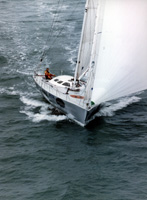 Garside's Magellan Alpha
Garside's Magellan Alpha
In Class II Garside had extended his lead over Mouligne to 53 miles. Yazykov dropped to
fourth place with his much smaller boat, but he was still showing great performance.
Meantime George Stricker was back in Cape Town for a second time. This time he returned
after a diesel fuel began leaking inside his boat. Davie, who was still working on his
boat, was supposed to start on Saturday, a week behind the fleet.
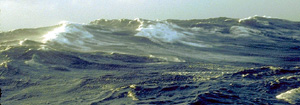
© Photo Richard Konkolski
Place |
Skipper |
Boat |
Latitude |
Longitude |
Dist. to go |
Speed |
Dist. to first |
Time |
1 |
Autissier |
PRB |
47 59S |
048 19E |
5465 |
13.9 |
0 |
2140 |
2 |
Soldini |
Fila |
46 29S |
048 31E |
5497 |
13.5 |
32 |
2140 |
3 |
Golding |
Team group 4 |
47 39S |
046 59E |
5522 |
13.8 |
57.1 |
2140 |
4 |
Thiercelin |
Somewhere |
46 06S |
047 00E |
5563 |
13.4 |
98.4 |
2140 |
5 |
Hall |
Gartmore |
45 57S |
042 50E |
5720 |
11.2 |
254.8 |
2140 |
6 |
Konioukhov |
Mod.Univ.Human. |
37 11S |
016 18E |
6996 |
3.7 |
1530.5 |
2140 |
Place |
Skipper |
Boat |
Latitude |
Longitude |
Dist. to go |
Speed |
Dist. to first |
Time |
1 |
Garside |
Magellan Alpha |
46 59S |
040 57E |
5762 |
10.2 |
0 |
2144 |
2 |
Mouligne |
Cray Valley |
46 53S |
039 33E |
5815 |
11.5 |
53.8 |
2144 |
3 |
Van Liew |
Balance Bar |
44 48S |
037 16E |
5959 |
7.3 |
197 |
2144 |
4 |
Yazykov |
Wind of Change |
44 11S |
037 12E |
5980 |
5.8 |
218.2 |
2144 |
5 |
Petersen |
No Barriers |
38 59S |
028 05E |
6493 |
7.3 |
731.6 |
2144 |
6 |
Saito |
Shuten-dohji II |
40 26S |
024 49E |
6561 |
4.7 |
799.8 |
2144 |
7 |
Hunter |
Paladin II |
38 59S |
025 01E |
6606 |
4.2 |
844.4 |
2144 |
8 |
Stricker |
Rapscallion III |
33 54S |
018 25E |
7046 |
0 |
1284.7 |
2144 |
9 |
Davie |
South Carolina |
33 54S |
018 25E |
7042 |
0 |
1280 |
1818 |
Copyright © Richard Konkolski
Return back to Second Leg
Return back to First Leg